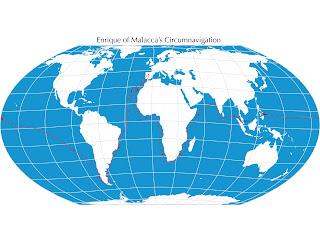 |
| Pigafetta's map of Patagonia. |
Written by Antonia Pigafetta, chronicler who sailed with Magellan's armada.
When one of his companions, who would never come to the ships, saw him coming with our men, he ran to the place where the others were, who came [down to the shore] all naked one after the other.
When our men reached them, they began to dance and to sing, lifting one finger to the sky. They showed our men some white powder made from the roots of an herb, which they kept in earthen pots, and which they ate because they had nothing else.
Our men made signs inviting them to the ships, and that they would help them carry their possessions. Thereupon, those men quickly took only their bows, while their women laden like asses carried everything. The latter are not so tall as the men but are very much fatter.
When we saw them we were greatly surprised. Their breasts are one-half braza long, and they are painted and clothed like their husbands, except that before their privies [natura] they have a small skin which covers them.
They led four of those young animals, fastened with thongs like a halter. When those people wish to catch some of those animals, they tie one of these young ones to a thornbush. Thereupon, the large ones come to play with the little ones; and those people kill them with their arrows from their place of concealment.
Our men led eighteen of those people, counting men and women, to the ships, and they were distributed on the two sides of the port so that they might catch some of the said animals.
Editor's Note: Ferdinand Magellan and his Armada de Molucca were the first Europeans to encounter the "Patagonian giants," whom chronicler Antonio Pigafetta described as so tall that "we reached only to his waist." Europeans on later voyages, including Sir Francis Drake's in 1579, also reported this race of giants living along the Patagonian coast (modern-day Argentina). The giants were likely Tehuelches, an indigenous people in the region.
(C) 2021 by Targets in English. All rights reserved.
Series: Magellan Chronicler Antonio Pigafetta Describes the Patagonian Giants
Part 1. First Contact Patagonia: Magellan and the Patagonians, Pigafetta 1
Part 2. Giants and Guanacos: Magellan and the Patagonians, Pigafetta 2
Part 3. Giant John: Magellan and the Patagonians, Pigafetta 3
Part 4. How to Capture Patagonian Giants: Magellan and the Patagonians, Pigafetta 4
Part 5. Culture of the Giants: Magellan and the Patagonians, Pigafetta 5
Part 6. Words of the Patagonians: Magellan and the Patagonians, Pigafetta 6
Part 7. Journey's End: Magellan and the Patagonians, Pigafetta 7
See Also:


